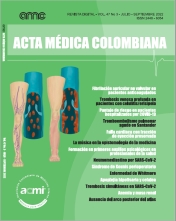Nonvalvular atrial fibrillation in anticoagulated patients
Abstract
Objective: to analyze the epidemiological and clinical characteristics of a population with nonvalvular atrial fibrillation (NVAF) treated with oral anticoagulation at Instituto Cardiovascular del Tolima in Ibagué, Colombia.
Reference framework: NVAF is a prevalent disease in Colombian patients over the age of 60, who are at greater risk of a cerebrovascular accident, which is preventable with anticoagulation treatment. However, complications inherent or secondary to the disease may occur despite treatment.
Methods: a cross-sectional study which describes the baseline characteristics of a total of 146 participants with NVAF being treated with oral anticoagulants, using information from their clinical charts between 2018 and 2019.
Results: of the participants, 53% were female, and 57% of the participants had permanent NVAF, this being the most frequent type in the study cohort. Ninety-nine percent were treated with nonvitamin K oral anticoagulants (NOACs) (76% with rivaroxaban), and 1% with a VKA (warfarin). Eighty-nine percent of the participants had a CHADS2 classification between 1-3 and 87% fell in the HASBLED 1-3 categories; of these, 95% did not have a CVA/TIA, 99% did not have a systemic embolism and 97% did not have major bleeds, respectively for each classification. There were no fatal outcomes in any of the patients.
Conclusions: an association was confirmed between CHADS2, CHADS2VASC2 and HASBLED classifications and CVA/TIA and hemorrhages in the study population (p<0.05).
Metrics
Copyright (c) 2022 Victor G. Aldana, Adriana Jiménez , Omar Suárez , Cristian Vera , Alejandro Torres

This work is licensed under a Creative Commons Attribution 4.0 International License.
Acta Medica Colombiana uses the CC-BY 4.0 license. Authors retain all rights over their work.


